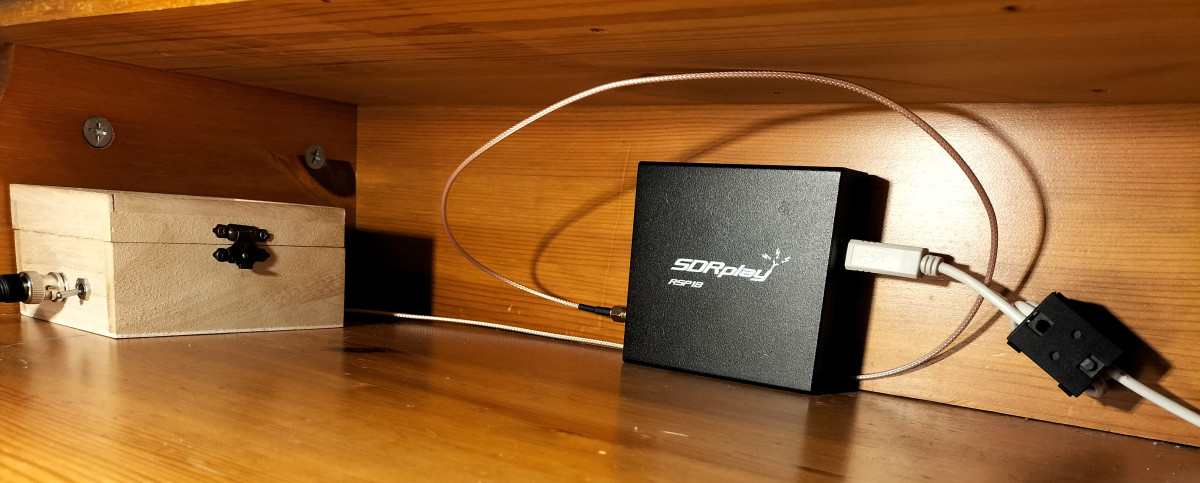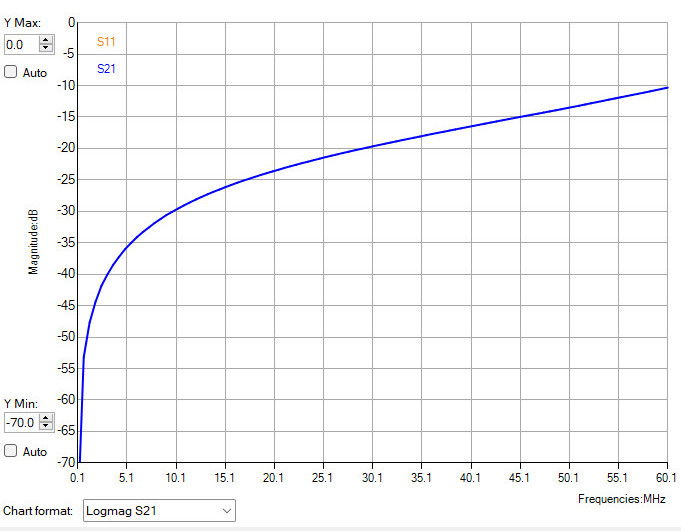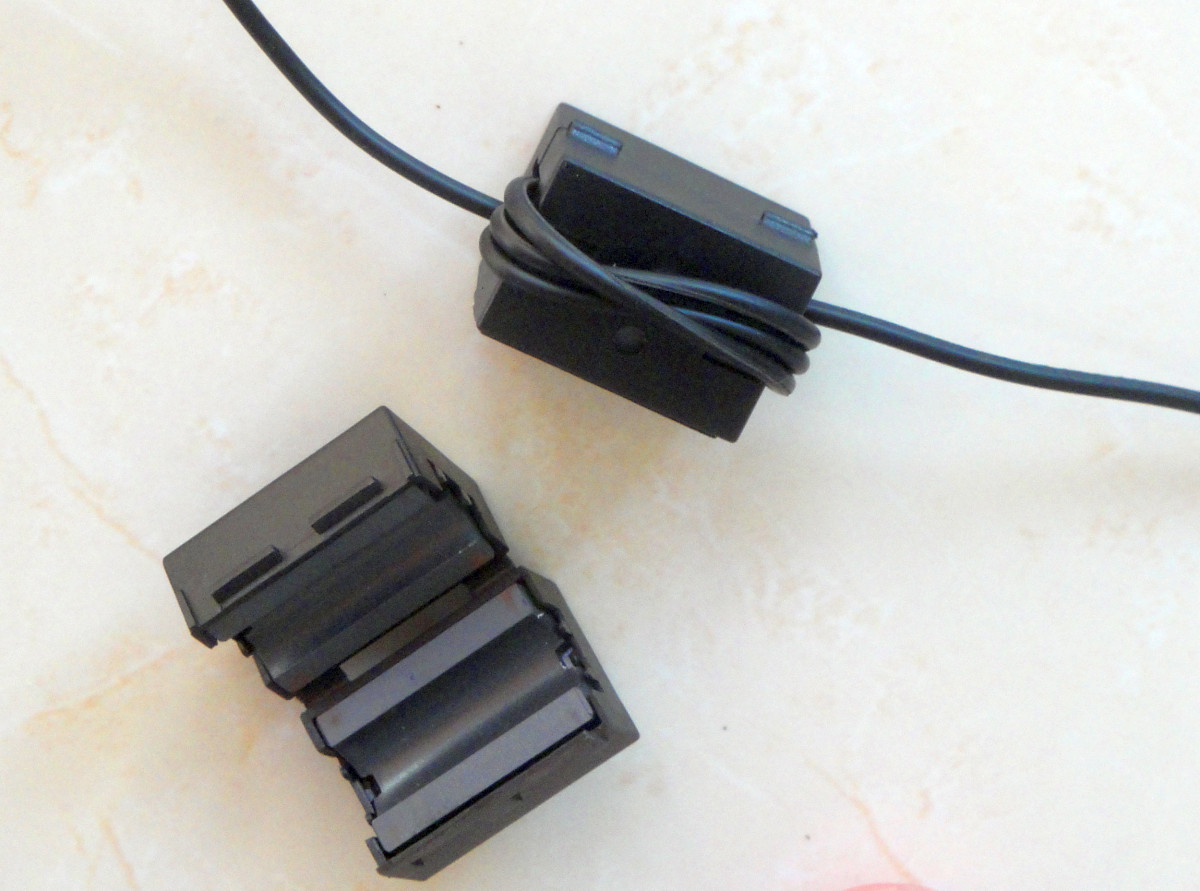SDR RECEIVER RSP1B of SDRplay
(2025)

The start of a new era! I bought a SDR receiver, a RSP1B of SDRplay!
And I made a "protector box". What a difference compared to my old receivers!
Link to RSP1B datasheet version 1.0
SDR receiver RSP1B of the company SDRplay
I bought a SDR receiver, a RSP1B of SDRplay! It can receive everything and all modes from 1 kHz to 2 GHz! A beautiful simple black box with only two connectors, an antenna input and a USB-B output! And not too expensive... What a difference compared to the old heavy and expensive military surplus receivers that had to be carried by two people! Inside the black box are tuners, bandfilters, direct sampling circuits, a low noise amplifier and a high performance 14 bits A/D converter. Can I throw away all my other receivers and replace them by this little box? But SDR receivers have a very vulnerable antenna input that can be easily destroyed! Not more than 1 mW continuous and 10 mW during a short time and no static electricity please! We cannot connect the RSP1B directly to a long wire antenna, I first want to make a safe setup before I start to use it!

The PA0RDT active mini whip!
A safe antenna is important!
Of course, you have to use an outdoor antenna for serious reception results. I found the PA0RDT active mini whip! It has a not too high output signal, but enough for a perfect reception, so the output signal of the active whip antenna does not overload the input of the receiver. It has a flat frequency response. It is protected by a non-conductive enclosure against static electricity and other electric discharges like static rain or during thunderstorms, the receiver will not be damaged! A small, inconspicuous antenna and omnidirectional! So a perfect outdoor antenna for this receiver!!!
However, I want an extra protector, the protector box!

The protector box!
The protector box!
The protector box is a simple thing. A high-frequency transformer that galvanically isolates the antenna and associated ground from the SDR receiver. So it is an extra insulation that protects the SDR receiver from electric pulses in the antenna circuit. And it has a capacitor of 10 nF. When I accidentally activate the bias-T power supply of the SDR receiver, it will not see a shortened circuit. The value of the capacitor is low, it attenuates frequencies below 200 kHz that I do not use.
And the box also protects the antenna from PC interference that flows to the antenna via the coaxial cable. Without the protection box, I have much interference below 2 MHz. With the protector box, the reception on medium wave frequencies is interference free. But for higher frequencies, the supression of that interference is lower due to the capacitance between primary and secundary windings. I added a switch so that the effect is audible and sometimes at high frequencies some spurs are lower when the switch is closed!

The protector box interference attenuation. More than 50 dB at 1 MHz!
Almost ready!
We are almost ready! We have a good, safe antenna and a protector box. And solved problems with static electricity by going barefoot in the shed!
We have to add some ferrite absorbers. One ferrite absorber in the coax cable. I use cheap, thin RG174 low quality Chinese coax, no woven screen. Do 3 to 5 windings around the ferrite absorber. And another ferrite absorber in the USB cable between PC and SDR receiver. If you have to buy such a USB cable with USB-B connector, you will not find it in the category "USB cables" but in the category "Printer cables"! We're going to install the software!

Almost ready, we have to add some ferrite absorbers for suppression of interference from your PC!

Attenuation of a ferrite absorber with 5 windings in a 50 ohm test setup.
Good at higher shortwave frequencies, but not so good at low medium wave frequencies
SDRconnect!
SDRconnect is the multiplatform software from SDRplay that I use. You can also use SDRuno (Windows only).
You can find it on the website of SDRplay: https://www.sdrplay.com/
Installation is easy and SDRplay has no manual but a Youtube tutorial that explains clearly how you can use the software. It is easy to use and does everything that I want and need. It is a pleasure to use with the spectrum screen. Excellent selectivty, frequency stability and accuracy! A very pleasant sound! Easy to tune with the mouse and mouse wheel! You can select various bandwidths and even create your own! For the FM broadcast band, I use the default sample rate of 2 MSPS but for the shortwave frequencies I use the lowest rate of 125 kSPS. That gives a perfect detailed spectrum view and shows you the spectrum of the whole CW part of an amateur band. So there is no reason to use a higher value!
For normal use, I have the AGC activated in the "SLOW" profile. And also the "IF AGC" is activated in the control menu. But for certain applications like QRSS reception, those AGC's have to be disabled and set manually. It is simple, if you disconnect the antenna, the noise floor should be lowered. If you do not see that, you have to increase the gain.

SDRconnect is the multiplatform software from SDRplay
And...
Awesome! From the first moment, it is my favorite shortwave receiver! Tuning is very comfortable with the mouse. Set the mouse pointer on the digit you want to use as the tuning step. Great that you can see 125 kHz of the spectrum or even more if you want. The frequency accuracy and stability is excellent. SSB, CW, AM, all kinds of digital modes, can be received. Excellent selectivity with selectable bandwidths. No overload if you use automatic IF gain. Navtex, Digital Selective Calling, medium wave broadcast stations, FM stations can be received with a perfect sound quality!
And there was a lightning strike in the garden, no damage thanks to the PA0RDT miniwhip with it's non-conductive enclosure and the protector box!

QRSS reception is perfect! Excellent frequency stability and accuracy due to the TCXO!
Will this SDR receiver replace my old receivers? Yes, the end of an exciting era!
Will this SDR receiver replace my old receivers? Yes! The old expensive receivers have already new owners. The home made receivers are carefully taken apart and the usable parts kept in the junk box. But the stories of those old receivers will be kept on this website!
Index PA2OHH








